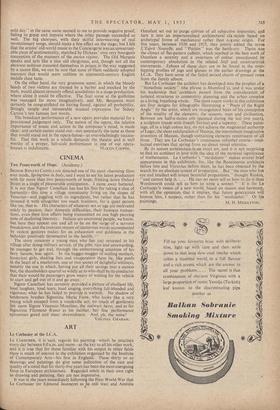ART
Le Corbusier at the I.C.A.
LE CORBUSIER, it is 'said, regards his painting—which he practises every day between 8.0 a.m. and noon—as the key to all his other work, and it is true that for those familiar with his output in other fields there is much of interest in the exhibition organised by the Institute of Contemporary Arts—his first in England. These thirty or so drawings and paintings do give some indication of the cast and quality of a mind that for thirty-five years has been the most energising force in European architecture. Regarded solely in their own right as drawing and painting, they are not impressive.
It was in the years immediately following the First World War that Le Corbusier (or Edmond Jeanneret asihe still was) and Amedee Ozenfant set out to purge cubism of all subjective impurities, aid turn it into an impersonalised architectural classicism based on archetypal forms of mechanical rather than of ginic origin. For five years, between 1920 and 1925, they jointly edited the revue L'Esprit Nouvelle, and "Purism" was the battle-cry. Theirs was the climax of flat-pattern cubism, which reached in the best work of Ozenfant a serenity and a sweetness of colour unsurpassed by contemporary absolutists in the related Strj/ and constructivist movements.. Echoes of those days are to be found in the over- lapping profiles of jugs and glasses in the earlier drawings at the LC,A. They have some of the faded period charm of pressed roses from the family album.
But Le Corbusier the architect has developed into the prophet of a "biotechnic society" (the phrase is Mumford's),-and it was under his leadership that -architects passed from the consideration of isolated structures to community planning and the urban complex as a living, breathing whole. The most recent works in this exhibition are four designs for lithographs illustrating a "Poem of the Right Angle" by the artist, which are strangulated hints of his conception of the totality of the elements, the seasons, man and civilisation. Between are half-a-dozen oils (painted during the last two years), a sculpture (made with Joseph Savina) and a tapestry. These paint- ings, all in a high colour key, do not achieve the magisterial authority of Leger, the sheer exhilaration of Matisse, the intermittent imaginative invention of Masson, though containing elements reminiscent of all three. They are Le Corbusier's continuous refresher course—intel- lectual exercises that spring from no direct visual stimulus.
By its nature architecture is an exact art, and it is not surprising to find an architect in love with the idea of the mystical significance of mathematics. Le Corbusier's " modulator" makes several brief appearances in this exhibition, for, like the Renaissance architects before him and Vitruvius before them, he has been obsessed by the search for an absolute system of proportion. But "the man who had eye and intellect will invent beautiful proportions," thought Ruskin, "and cannot help it.... He can no more tell us how to do it than Wordsworth could tell us how to write a sonnet." It is for La Corbusier's vision of a new world, based on reason and harmony, with all. the optimism that it implies, that future generations will honour him, I suspect, rather than for his "modulator." Or his


































 Previous page
Previous page